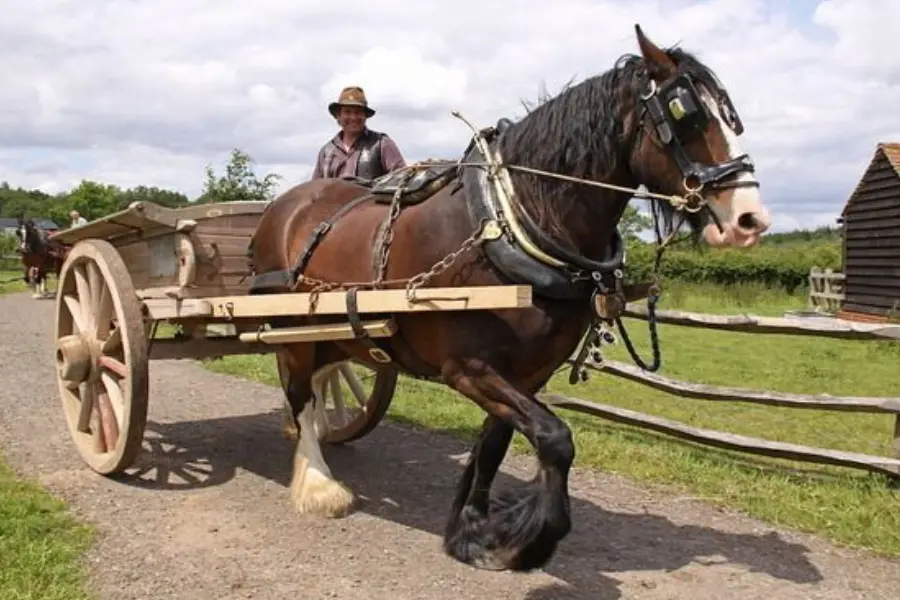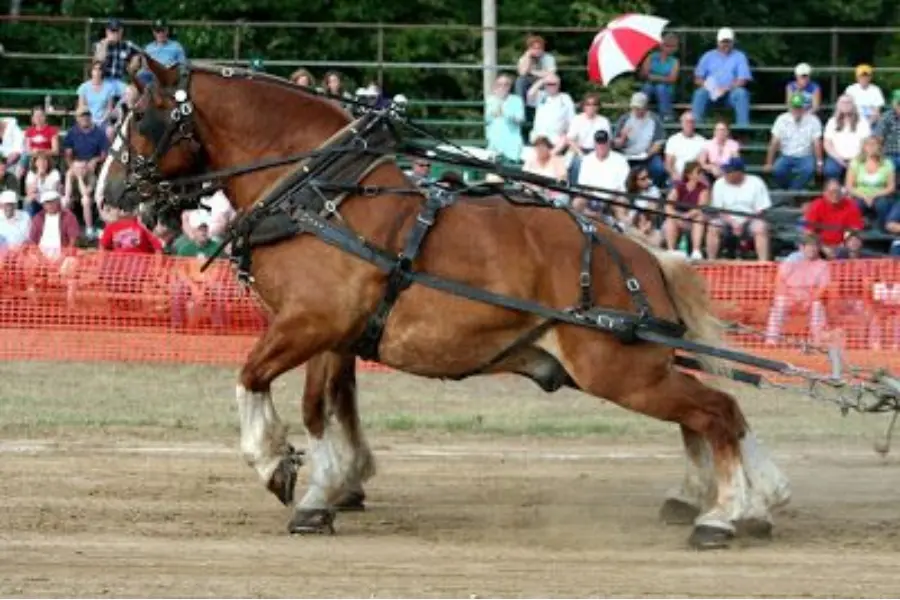How Much Weight Can A Horse Pull? Surprising Truth Revealed

The most constantly asked question is” How much weight can a horse pull ?”. The world as we know it was partly shaped and erected by horses. Utmost horses currently lead more laid-back lives than those of their ancestors. This is important for those interested in horse-drawn conditioning. A horse can pull in a lot of fields including forestry, husbandry, and carriage lifts.
Whether you use your horse for pulling, hauling, riding, or personal service, knowing and controlling your horse’s weight is critical. By transporting a suitable weight, you not only protect the long-term health but also increase the longevity of your beloved horses. It would be best if you carefully read all the answers you need in this article.
How Much Weight Can A Horse Pull?

So, how much weight can a horse pull? Energy is substantially determined by several factors, including breed, size, training, and kind of load. A well-trained horse can pull 1.5 to 2 times its body weight on short distances on average.
Several criteria need to be taken into account when determining the weight a horse can pull. Start with the following general insights:
- A horse can usually drag 10-15% of its body weight. For example, a 2,000-pound horse can pull a 200-pound log or a large granite slab. A horse can pull much more, though, when the load is on a wheeled cart or carriage. Over long distances, it can pull up to 1.5 times its body weight, thus a 2,000-pound horse might tow a 3,000-pound cart.
- Some horse types, particularly those bred and trained for hauling, can pull up to 15 times their body weight over short distances. A trained 2,000-pound horse, for example, might be suitable to pull a 20,000-pound cargo. Clydesdales and other sturdy draft breeds can easily pull 10,000 pounds (4,535 kg).
- The distance of the pull is crucial; similar to humans, horses can only sustain maximum effort for short stretches. When two horses work together, they can pull three times the weight that a single horse can manage. Trained competition horses are capable of pulling well over their body weight, even when dragging dead weight.
The Difference Between Types Of Horses In Pulling Capacity

When opting for tasks for your horses, you should consider the weight of horse can pull. Once the differences between types of horses are known, horse breeders and users can make appropriate adjustments.
- Riding Horses: Riding horses are typically lean and swift, excelling in speed and agility. While they are capable of pulling weight, their primary strengths lie in tasks such as rounding up cattle and inspecting fences. Their quick pace allows for faster travel, and they are generally less expensive to care for and feed. Initially, riding horses might be a bit skittish until they become familiar with their handler.
- Draft Horses: In contrast, draft horses are much bulkier and muscular. They are quite good at hauling plows or buggies because they are made for heavy-duty work. Draft horses can pull carriages at a steady speed. They can also drag more than their body weight over short distances. They are known for their calm and steady nature, rarely getting startled.
Best Horse Breeds for Pulling

Some horses are better suited to carrying heavy burdens, and draft breeds excel in this regard. Draft horses are usually larger and stronger than the typical riding breeds. For example, many horses can pull the weight of around 1,100 pounds (500 kg), whereas a typical draft horse might weigh more than 1,600 pounds (725 kg).
Draft horses are bred and trained to do hard jobs. A horse can pull big loads in carts, carriages, and even train cars. They are also used for mowing fields. Here are some of the top draft breeds renowned for their impressive pulling power:
- Belgian Draught Horse: Originating in Belgium, the Belgian is one of the largest and strongest kinds of draft horses. These horses can be identified by their short legs, broad necks, and strong bodies. They are also known for their placid disposition. Belgians were traditionally employed on farms, towing carts and artillery. They weigh about 2,000 pounds (907 kg) and can reach a height of 19 hands. Notably, at 20 hands and 2.75 inches tall, Big Jake, a Belgian, used to hold the Guinness World Record for the biggest horse still in existence.
- Shires Horse: Hailing from England, Shires horses are the largest and heaviest horse breed. These gentle giants have broad chests and strong hindquarters. In the Middle Ages, they were war horses and pulled heavy loads, like brewers’ drays and barges. A Shire named Sampson holds the record for the largest and heaviest horse ever. He stood at 21.2 hands and weighed 3,360 pounds (1,524 kg).
- Friesian Horse: One of the oldest horse types in Europe is the Friesian, which began in Friesland in the Netherlands. generally black with long flowing manes and feathered legs, these stunning horses are. They weigh roughly 1,500 pounds( 680 kg) and have a reach of about 17 hands. In the Middle periods, Friesian horses were employed for combat, and later they were trained to drive carriages. They have a character for being wise, kind, and motivated to work.
- Percheron’s Horse: The Percheron is a large, elegant draft horse. It has a refined head, a broad forehead, and clean legs. It comes from the former province of Perche in France. Percherons were agile, intelligent war horses in the Middle Ages. Later, Percheron’s horse can pull coaches and heavy equipment. They can stand up to 19 hands high and often weigh over 2,000 pounds (907 kg).
- Clydesdale Horse: This breed is named after Scotland’s Clydesdale Valley. It’s altitudinous and muscular, but lighter than other heavy types. Clydesdales have elegant heads, arched necks, and leaning shoulders. They generally have white markings and silky feathers on their legs. Clydesdales, used for farm work, haulage, and forestry, stand 16 to 19 hands altitudinous and weigh over 2,100 pounds( 952 kg). They’re also well-known for pulling the Budweiser beer cart in processions and advertisements.
What Are Factors Affecting A Horse’s Pulling Ability?

To evaluate a horse’s pulling ability, below is a thorough examination of the key components that affect horses’ weight to manage various loads. Combined with the answer to ‘how much weight can a horse pull’, horse users will then make appropriate adjustments. Remember, pulling too heavily will affect the horse’s lifespan.
- Deadweight vs. Wheels: A load termed as “deadweight” is challenging to move because it’s not easy to shift. However, adding wheels to the load significantly simplifies the operation. Horses can pull much more weight when they are on a wheeled cart than deadweight. Furthermore, the weight of the horse will be proportional to the weight of the load.
- Distance Covered: Pulling big loads for long distances is extremely demanding on a horse’s heart, lungs, and muscles. Horses can only carry maximum loads for short distances before becoming fatigued. In addition, the speed of a horse at which the horse pulls over that distance also greatly affects the horse’s ability to pull.
- Terrain: The difficulty of pulling weight increases with challenging terrain. Moving heavy loads on a flat, smooth surface is easy. But, uneven or waterlogged ground makes it much harder. Steep inclines can halt progress entirely.
- Weather: Cooler temperatures are better than hot, humid ones. They make it easier to exert yourself. The heat might lead to weariness and reduced performance.
- Horse’s Temperament: A horse’s attitude and willingness to work significantly affect its pulling capacity. Some horses are more motivated and better suited for hard work.
- Horse Breed: The breed of the horse often indicates its pulling power. Horses bred for heavy hauling tasks have the needed traits for these tough jobs.
How To Prepare Horses To Pull
Preparing horses to pull efficiently requires adherence to a rigorous training program to adapt to the issue the weight horse can pull. Every horse is different. So, conditioning must suit each one. This ensures they can handle higher loads. For best outcomes, follow these 5 essential steps:
- Gradual Conditioning: Increase the intensity of strength and conditioning exercises gradually. This lets the horse’s body, mind, and heart adapt safely. Include rest, recovery, stretching, and possibly massages to aid training.
- Properly Fitted Equipment: Ensure you use the right tack for pulling, with proper fit and adjustments. A well-fitted harness and shoes with adequate traction are crucial. Always check for and alleviate any pressure points when fitting the tack. Always provide enough water for the horses to the horse after a period of heavy pulling.
- Nutrition: A balanced diet is necessary for the development of muscle and strength. To meet your horse’s needs, feed him a balanced diet. It should be rich in fruits, vegetables, energy supplements, and oats
- Ongoing Monitoring: Track your horse’s progress. Note its reactions to changes in diet, exercise, rest, and sleep. Frequent evaluation enables necessary modifications to the training regimen.
- Frequent Vet Checkups: To evaluate and direct the strength and fitness program, see a veterinarian. The horse’s health and well-being must be continuously monitored. This should include routine veterinary exams.
FAQs
A healthy horse can generally carry up to 20 of its body weight. However, it may handle up to 25 of its weight, including the saddle, If the horse is in good condition and the rider is endured. An unfit horse or an inexperienced rider will probably reduce this capacity.
Draft types exceed in carriage driving, where they pull a carriage through a course. Also, Welsh Ponies, Hackneys, Morgans, Atomic Horses, and Quarter Horses exceed at carriage driving.
Final Thoughts
So, how much weight can a horse pull? The answer depends on a range of factors, from the horse’s strain and training to the type of load and terrain. Always prioritize the horse’s safety. Follow training protocols and know its limits. With the right approach, you can keep your horse healthy and strong while it pulls. Knowing these factors and taking precautions will keep your horse safe. They will also help you maximize its pulling power without causing harm.



